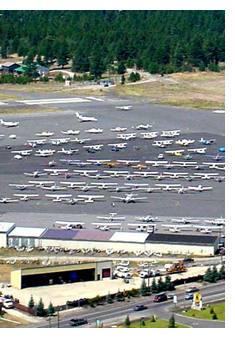
Airport system study reveals value of Idaho's airports;
– annual payroll calculated at $718.5 million –
ACEC selects Airport Plan as best The Idaho chapter of the American Council of Engineering Companies recently selected Idaho’s comprehensive airport system plan for one of its annual awards. It will be honored as first-place winner for Studies, Research and Consulting, as part of the 2010 Engineering Excellence Awards competition. The award will be presented April 11 at an awards luncheon in Boise. |
An integral part of Idaho’s transportation system, airports face needs that are similar to highways for infrastructure improvements, planning and funding.
The Division of Aeronautics now has a tool that will help define the future of those airports. It comes in the form of an Idaho Airport System Plan, completed in 2010 after about two years of research.
The study, explains Aeronautics project manager Bill Statham, was funded by a Federal Aviation Administration grant and began in 2008. It was prepared by the airport division of Wilbur Smith Associates, a group of engineers, planners and economists who worked with Statham and a local advisory committee. The company is based in South Carolina, with a regional office in Arizona.
T-O Engineers, HDR and ES Engineering assisted with the project.
 “Success of the study is due in large part to Bill’s leadership. He did an outstanding job guiding the process and keeping the study on track,” said JV DeThomas, Division of Aeronautics administrator.
“Success of the study is due in large part to Bill’s leadership. He did an outstanding job guiding the process and keeping the study on track,” said JV DeThomas, Division of Aeronautics administrator.
The goal, according to the study’s executive summary, is to “provide a blueprint to ensure that Idaho’s future system of airports meets the state’s needs as viewed at a macro or top-down perspective. This approach allows each airport’s role in the system, its demand for aviation, and infrastructure to be evaluated in this larger context.
“This study can also be used to provide increased accountability for funding decisions.”
“We came up with an overall funding needs assessment for the next 20 years,” Statham said. “It is a fairly detailed report card on how well the system is functioning. “
Recommendations from the study are “conservative and reachable,” Statham explains.
“We wanted to take a realistic approach. Idaho’s airport system needs investments of nearly $739 million over the next 20 years. That is about $150,000 more in state participation per year than the current base funding. It is well within reach if our economy improves. The goal is attainable.”
The study was a “top-down” process that considered a statewide evaluation and inventory of the airport system. It established performance measures based on a review of 75 public-owned, public-use airports.
They included:
-
All seven commercial service airports
-
14 airports with more than 25,000 annual operations
-
87 runways in the system, including three water runways at seaplane bases
-
23 runways that are more than 5,000 feet in length
-
63 paved runways, 13 turf-only runways and three water runways
-
18 airports with automated on-site weather reporting
-
38 airports with fuel service, and
-
Eight airports with more than 100 based aircraft
The study indicates those 75 airports are located within a 30-minute drive of 89 percent of Idaho’s population.
“I was particularly surprised with that because Idaho has a modest program when compared with funding of other state airport systems. I think we’re doing pretty well,” Statham said.
“Of the 27 benchmarks selected for analysis of the Idaho airport system’s performance, many are considered informational, providing ITD and the airports with data for future tracking and monitoring,” according to the executive summary. “Other benchmarks offer the opportunity for action to improve the performance.”
The base number of aircraft is expected to grow modestly, from 3,638 in 2012 to 3,889 in 2017 and 4,428 by 2027. Annual aircraft operations are projected to go from 1.6 million to 1.7 million and 2 million during those years, while the commercial airline emplanements should grow from 2.6 million, to 2.9 million and 3.9 million by 2027.
Idaho’s airport system remains a significant contributor to the state’s economy, according to the system plan. Airports and related operations account for 23,000 jobs (2.9 percent of all jobs in the state), with an annual payroll of about $718.5 million. Airports have an estimated annual economic impact of $2.1 billion on the state’s economy.
Airports “serve as vital business links and support critical services, such as medical care, agriculture, search and rescue, wildland fire fighting, law enforcement, recreation and environmental services,” according to the report.
Policy recommendations 1. Promote compatible land use near airports through use of the Idaho Airport Land Use Guidelines, education and land use legislation to address evolving issues |
Published 1-14-2011